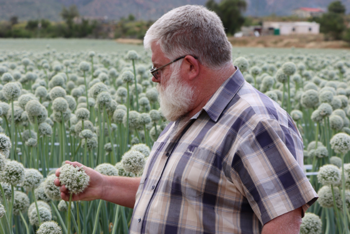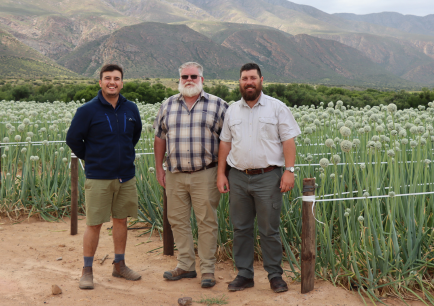Decades with Driplines: Precision and Onion Seed Production
Derick Human from Snyberg, near De Rust in the Klein Karoo, has been farming onion seed for nearly 36 years and installed his first Netafim drippers 28 years ago. “I started with Ram drippers, moved to UniRam™, and now I’ve also transitioned to Streamline™ X thin wall driplines,” he says.
Human explains that they successfully irrigated onion seed with pressure-compensated heavy wall driplines for many years. “Initially, we used 3.5 ℓ/h drippers, but later switched to lower flow rates as irrigation practices and other conditions changed. This was the best option for the farming and market conditions, and with proper management and maintenance, we ensured the driplines delivered reliable performance in our onion seed fields for many years.”
“There were certainly challenges, such as damage during the rolling out and retrieval of the driplines, sections that needed repairs, and other issues that could lead to inefficient irrigation. However, these challenges were manageable with good farming practices.” He explains that, for several reasons, thin wall solutions have become the better choice. “One reason is that they provide a better balance between input costs and field performance. We’re also dealing with increasingly poor water quality, which raises the risk of clogging. That’s why switching to seasonal drip irrigation makes more sense.”
A Valuable Mindset Shift
About two years ago, Human switched the majority of his onion seed to irrigation with Streamline™ X thin wall driplines, using 1 ℓ/h drippers spaced 0.3 meters apart. “Netafim visited me and clearly outlined the benefits and value of the product. I decided to give it a go and I have no regrets. It’s truly an excellent product for onion seed production.”
According to Human, the biggest advantage is starting each season with new, clean driplines. “This ensures high efficiency and that every plant receives the precise amount of water and fertilizer it needs.”
Human acknowledges that he had to change his mindset to transition to thin wall driplines, but the benefits have made it worthwhile. “There are many factors to consider, such as lateral length, scheduling, and more. One of the benefits is that we now use fewer dripline connectors. My wife jokes that in the past, she had to buy connectors every time she went to town, and that she can definitely notice the difference now.”
A major factor driving the onion seed industry’s shift to thin wall driplines is the preference for closer dripper spacing to optimize irrigation. Human explains that narrower spacing delivers undeniably better results. “I find that the plants establish better and that I can apply water and fertilizer more efficiently overall. In the past, we had to use wider spacing to balance input costs and revenue. As explained earlier, closer spacing with long-term drippers wasn’t economically viable. However, with thin wall driplines and a more affordable dripper that only needs to last one season, closer spacing is now financially feasible, allowing me to irrigate more efficiently.”
Water quality remains a major challenge, according to Human. “Especially in drought years, water quality deteriorates significantly. There have been instances where we had to over-irrigate by up to 35% just to leach salts from the soil. We endured eight years of drought and are now grateful for a few years of much better rainfall. However, I’m curious to see how the Streamline™ X drippers will perform when salts and other water quality issues worsen again. I believe the driplines will hold up, especially with good filtration and management.”

Drip irrigation is undoubtedly the best irrigation method for onion seed as onion plants need wet roots but dry conditions at the flower.
Don’t Forget the Filter
Human has two Netafim AlphaDisc™ filters operating on his farm. “When I speak to farmers who are negative about drip irrigation, I find that they often don’t have proper filtration. It’s crucial to understand that your filtration needs to be correct if you want to farm with precision. Filtration is one of the most important components of irrigation - without it, you won’t get water to your plants. I believe in proper filtration so I can achieve optimal yields from the money I invest in driplines and pumping costs. Last season, we used 160 000 meters of Streamline X, and in that time, we had to replace less than 300 meters due to clogging or damage. That’s a negligible percentage, thanks to good filtration, quality driplines, and proper management.”
Drip irrigation is undoubtedly the best irrigation method for onion seed, says Human. “This is because onion plants need wet roots but dry conditions at the flower. Only a dripper can ensure that the plant gets optimal water and fertilizer while maintaining a dry environment - this allows bees to pollinate effectively, reduces disease, and prevents plant damage. We need to understand irrigation technology so we can continue making it work for our farms.”
He adds that the success of drip irrigation doesn’t only depend on quality products but also on management. “If you don’t manage drip irrigation properly, it won’t work. That’s why it’s important to understand your soil type. I have sand, clay, and various other soil types, and I successfully use the same driplines across all of them.”
Essential Precision
Regarding the increasing role of precision in farming, FT Human, the next generation at Snyberg, emphasises that sustainable farming is no longer possible without precision. “We all know that farming margins are getting tighter, and in South Africa, we don’t have subsidies to fall back on. Every input and management task must be handled with 100% precision to produce as much as possible with minimal inputs. You can no longer afford to lose a percentage of your water and fertilizer due to inefficient irrigation and nutrient delivery.”
This level of precision naturally requires investment in technology. “There are many farming solutions available that help us farm with increasing accuracy. I fully support using these solutions but always remind myself that real precision also requires balance. We must remember that over-investing is a risk, and we need to be precise in our decisions about which solutions to implement.”

Byron la Trobe, Netafim Technical Advisor, with Derick and FT Human.
Lean Years and Good Years
Human says that onion seed farming keeps you on your toes. “One year, the bees won’t work, or you won’t have enough water, or you’ll only get 50% yield - or no crop at all. That’s part of farming. So many factors play a role, and there’s so much we can’t control. That’s exactly why we must manage what we can control with precision. If, for example, we can make irrigation a constant, we can handle other factors more effectively. When I get home in the evening, I need to know that I’ve done everything within my power to achieve the best possible results.”


Share your thoughts
Comments
We'd love to hear your thoughts! To enter a comment, type your name and email address.